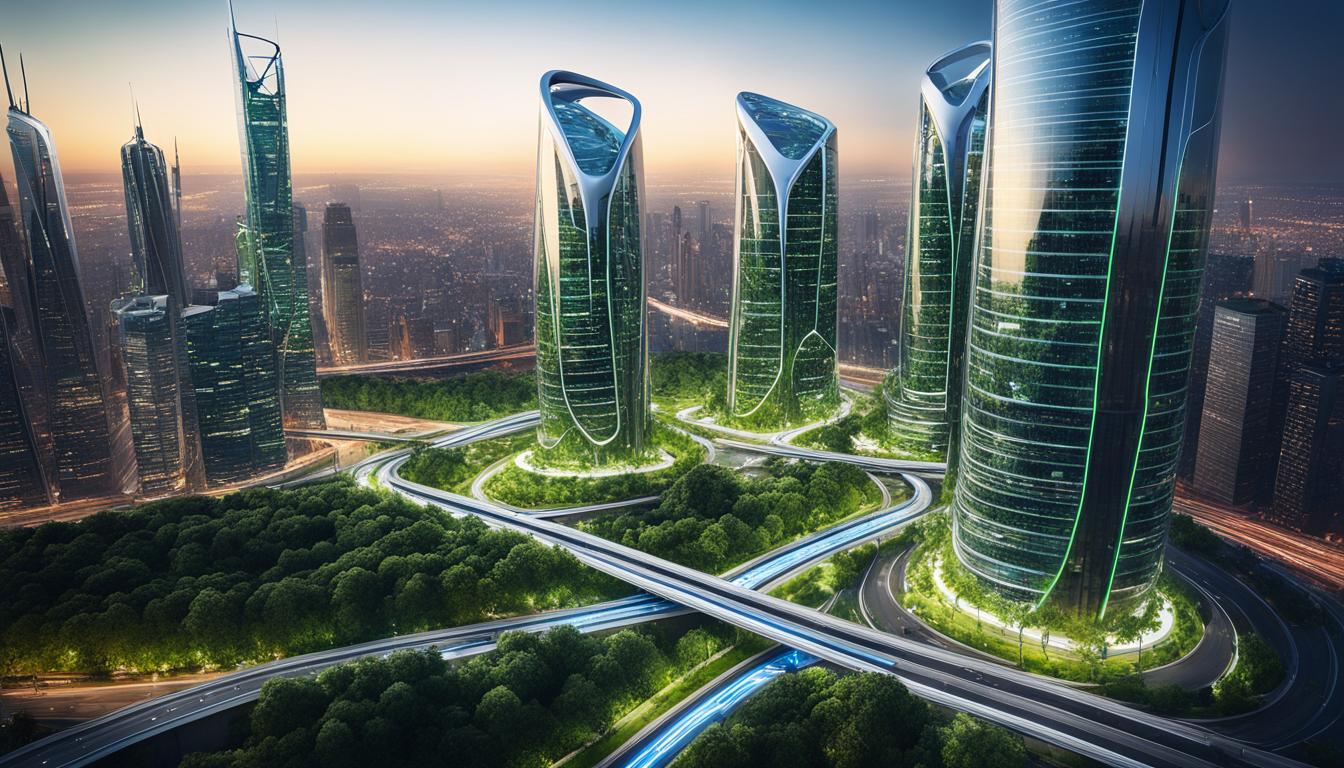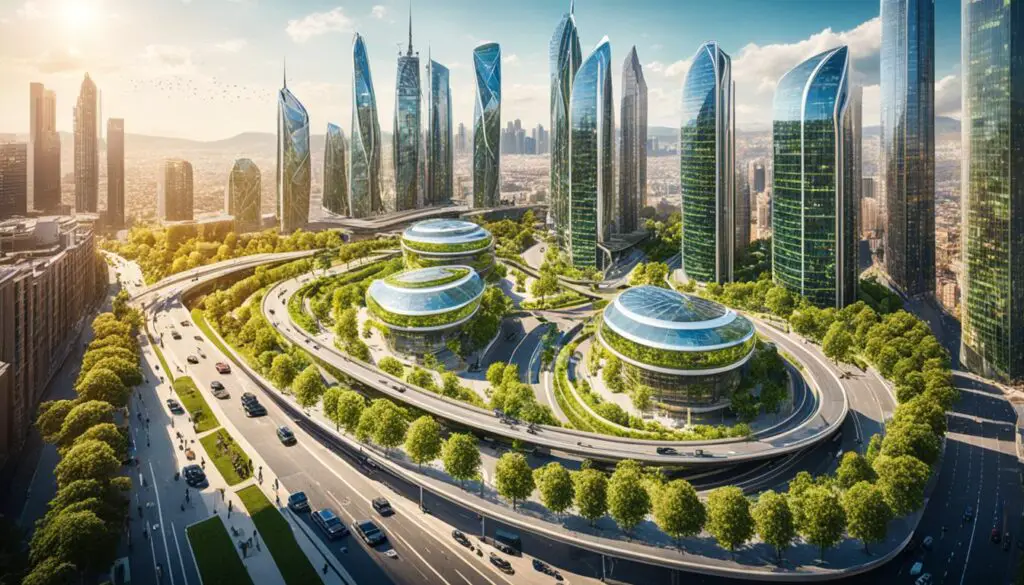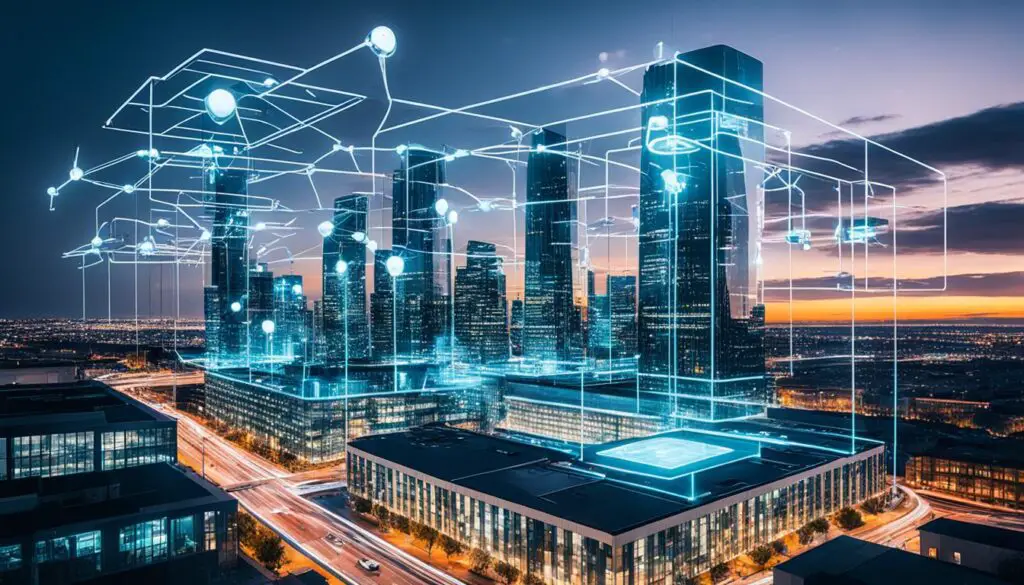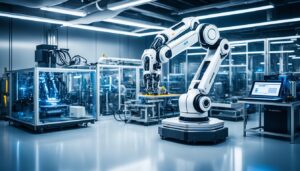
Smart cities are changing how we live in urban areas. They use artificial intelligence (AI) for a sustainable future. Technologies like the Internet of Things (IoT), cloud computing, and blockchain improve city life. They make our urban experiences safer, easier, and more efficient.
The number of people living in cities is growing. Because of this, building smart cities is essential. AI helps these cities manage resources better and make smarter choices. This leads to a brighter future for everyone.
Key Takeaways:
- Smart cities utilize AI technologies for enhanced infrastructure, government services, accessibility, and economic development.
- The integration of AI in urban areas aims to make cities more comfortable, safer, and efficient.
- AI technologies like IoT, cloud computing, AR, and blockchain contribute to the development of smart cities.
- The global population residing in cities continues to rise, emphasizing the need for smart city development.
- AI plays a pivotal role in optimizing resource allocation and improving the overall quality of life in cities.
Understanding Smart Cities: A Quick Primer
Smart cities use digital tech to make urban life better. They use things like the IoT, AI, and blockchain to upgrade infrastructure and services. This leads to better government services, more jobs, and a healthier environment.
More than half the world lives in cities now. This makes smart cities crucial for efficient management and better living.
Integrating IoT devices helps transform cities. It enhances municipal services through real-time data. This leads to better management, safer transportation, and stronger safety measures.
Smart cities modernize government services too. They make use of tech to simplify processes. This makes dealing with government faster and easier for everyone.
Improving infrastructure is key. Digital tech paves the way for smarter buildings and eco-friendly solutions. This not only saves resources but also promotes growth and green efforts.
Accessibility is central to smart cities. Tech helps everyone access services easily, including those with disabilities. It makes life better for everyone in the city.
In the words of urban planner Jane Jacobs, “Cities have the capability of providing something for everybody, only because, and only when, they are created by everybody.” Smart cities embody this idea. They use tech and citizen input to meet everyone’s needs.
Sustainability is important in smart cities. Using tech in planning and management leads to better environmental practices. Smart grids and renewable energy are just some ways cities are becoming more sustainable.
Smart cities also boost the economy. They attract businesses, create jobs, and drive innovation. Technology integration boosts the city’s economic strength globally.
As cities grow, smart city solutions become essential. With digital tech, cities evolve into sustainable and inclusive places. This makes life better for their residents.

| Enhanced Infrastructure | Modernized Government Services | Increased Accessibility | Sustainability Efforts | Economic Development |
|---|---|---|---|---|
| Optimized resource usage | Streamlined administrative processes | Inclusive and accessible services | Environmental performance | Business attraction and job creation |
| Efficient transportation systems | Efficient service delivery | Improved quality of life for individuals with disabilities | Mitigation of climate change | Drive innovation and competitiveness |
| Sustainable waste management solutions | Accessible online portals and mobile applications | Smart transportation systems | Intelligent waste management | Economic resilience |
| Integrated energy networks | Automated systems for citizen interactions | Assistive technologies | Water conservation initiatives | Job opportunities |
AI in Action: Transforming Smart Cities
Artificial intelligence (AI) is changing smart cities for the better. It drives innovation across various sectors. Through real-world examples, we see AI enhance urban safety and optimize waste management. It also makes IoT-enabled furniture better and improves road maintenance. Plus, it’s great for managing traffic with data.
Urban Safety: AI-powered cameras in urban transit systems are revolutionizing safety and efficiency. These smart cameras monitor traffic flow and detect accidents instantly. They can even spot potential security threats.
Waste Management: Smart bins with sensors are making waste collection smarter. They use AI to know when they’re full and find the best collection routes. This cuts costs and makes resource use better.
Urban Furniture: IoT-enabled urban furniture is smarter with AI. It helps monitor air quality and use. These technologies track pollution and water use, making cities more energy-efficient.
Road Maintenance: AI helps with road upkeep by studying data from road sensors. It spots problems like cracks or potholes early. This keeps roads safe and smooth.
Traffic Management: AI-based traffic systems make traffic flow better. They cut down congestion and make transport more efficient. By studying data from various sources, AI adjusts traffic signals and suggests alternate routes.
These examples show AI’s power to make urban living better. It makes cities more efficient, sustainable, and pleasant to live in. By using AI, smart cities are becoming safer, more optimized, and environmentally friendly.

Conclusion
The use of AI in developing smart cities is changing the game. It makes managing resources, making decisions, and living better much easier. AI leads the way for cities to grow in a smart, strong, and new way.
For smart cities to keep improving, those in charge must use AI smartly. They also need to think about its effects on society.
To make the dream of “Better City, Better Life” come true, we must make sure everyone can use the technology fairly. And keep their data safe. This will help cities grow well, face challenges, and bring in new ideas. By tackling the hurdles of using AI, smart cities lay the groundwork for a brighter future.
FAQ
What are smart cities?
How does AI contribute to smart cities?
Can you provide examples of how AI improves smart cities?
What challenges does the deployment of AI in smart cities pose?
How does AI contribute to sustainable growth and resilience in smart cities?
Source Links
- https://medium.com/@lleep1997/smart-cities-and-ai-building-the-urban-landscapes-of-tomorrow-1d79e5587ef0
- https://www.linkedin.com/pulse/building-tomorrow-transformative-role-ai-shaping-smart-birai-niioc
- https://journalofcloudcomputing.springeropen.com/articles/10.1186/s13677-023-00569-6






